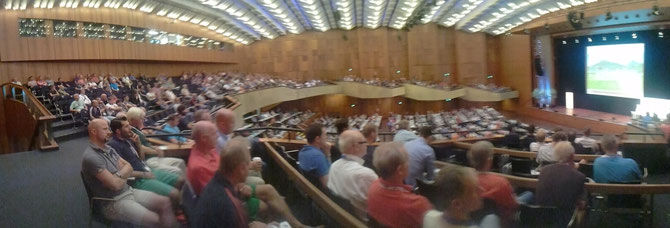
On my annual leave I was able to attend the international coaching conference of the German Football Association at Mannheim from the 28.-30.7.2014.
About 1200 participants from 30 nations attended the conference.
The focus of the first day was mainly on the 2014 FIFA World Cup.
The first session (Monday 28.7.) was about why and how the DFB observed all games of the World Cup starting from the round of 16. At least 2 DFB staff attended each game (one for each team) with
the purpose to observe possible trends in style of play of the teams. “Trends” were then analyzed with regards to offensive and defensive actions/behavior of the last four teams: Brazil,
Argentina, Netherlands and Germany.
There seemed to be a variety of game-concepts.
Germany started in a 4-3-3 and pressed the opposition (generally) in the midfield, however if given also already very high in the opposition half or very deep in their own half.
The distance between the players were very short and all players commited defensively. Usually, Germany tried to press immediately after losing the ball and the goalkeeper was very active. The
offensive game was controlled, with a focus to keep possession however, when possible to pass vertically to increase the pressure on the opposition with the target to score.
Argentina generally operated in a 4-4-2 (defensively) and a 4-3-3 (offensively). The pressing derived from a defensive block of a total of 8 players who were positioned very deep
and inviduals attempt to win the ball. Messi and Iguain (& Di Maria at times) rarely perform defensive work. Offensively, the back 4 were more dynamic acting more as a 3, with the fullback
more or less inactive with Mascherano as the key player and Messi, Iguain and Di Maria more or less performing attacks with limited support from teammembers, as there was no long ball circulation
to keep ball possession.
Netherlands used a 5-2-3 (defensively) and a 3-3-2-2 (offensively). However, there were many different system of play used and 5 backline players with two “double-6” in front of
the back line who operated very deep in the own half. From time to time individuals were man-marked and 1 player of the back-5 followed the opposition players into the midfield and dropped back
after. Offensively, a back 3 tried to get the ball into the midfield, which took very long from time to time and the ultimate solution was a long pass to Robben and van Persie in many
cases.
Brasil operated in a 4-2-3-1 offensively and used a 5-2-2 defensively. There did not seemed to be a discipline defensive strategy and furthermore due to uncoordinated offensive
action there was a lot of space after loosing the ball to the opposition. Long balls were used offensively (rarely any short passes combination) with Neymar the dominant recipient. Hulk and
Marcelo were also effective from time to time.
As a result, there seemed to be a variety of system and the back 4 does not seems to be “written in stone”. Tactical variability seemed to be key in combination with a structured but
creative midfield. Many times a back-5 was priorities to secure the defense and only in limited situations the teams chose to re-possess the ball in the opposition half. Counterattacks were
performed with 2/3 players. Offensively, players rotated positions sometimes and a true number 9 striker was present to have a presence as deep as possible. Individual qualities in 1-on-1 were
also seen as key in defensive and offensive plays.

The afternoon was used to demonstrate the history, aims and key aspects of a video analysis. This coaching tool was seen as a structured presentation of the opposition with 12-15 minutes in
duration to demonstrate the strength and weaknesses of the opposition. The responsibility of the coach should be to show solutions to deal with given situations.
Video analysis should be able to “answer” the following criteria:
- What is the tactical system of the opposition offensively and defensively?
- How is build up of the opposition? Is there a first pass, if so who plays it and to who/where
- What is the defensive tactical strategy? Who is the first line of defence?
- What is the attacking style and who are the most dominant players?
- What is the team, group and invidual characteristics of the team?
- How is the opposition in transition?
- What is the reaction from the coach when leading/losing? Substitutions?
- What are the options/preferred choice to counterattack
- When are where are the spaces which are created by the offensive actions of the opposition and how can they be used?
- Individual weaknesses? Folding under pressure?
- Offensive and defensive movements during offensive and defensive set-pieces?
- What are the different options of the oppositions set-pieces?
- …….
And of course every individual coach can add personal things he/she wants to see/have.
 Footballscience.net
Footballscience.net
